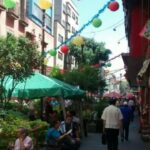
In 1592, the Viceroy of New Spain, Luis de Velasco, 1st Marquess of Salinas, ordered the creation of a place for recreation to the west of the city. A rather wide avenue was drawn out, straight from the center of the city and lined by no fewer than nine chapels. The Alameda Central, surrounded as it was by stone walls and some of these chapels, became an ideal people for couples to meet.
Under the much later government of Ignacio Comonfort (1855 to 1858), the nice chapels were demolished in an early pique of what was to come in the Reforma. Surrounding streets became even more labyrinthine, and presented a problem in the ample escape routes afforded to the criminals of the day.
One of the most famous tales to have emerged from the chaotic city of the 19th century occurred on the Callejón de las Mujeres, just off the Calle de Dolores in what is today Mexico City’s Chinatown. According to the legend, the rather dank little alleyway was known then as the Callejon Sal Si Puedes.
Such a name seems to imply that one can’t exit the street, or “come back out if you can.” Others insist the name was taken from a newspaper of somewhat ill-repute published in the area.
It’s said that into this atmosphere arrived the wealthy and upper-class Spanish Olivare family all the way from Spain. The rather drastic trans-oceanic move was made to avoid unwelcome attention being directed at the youngest daughter by an even wealthier Spanish millionaire. But upon the family’s arrival in Mexico, the young woman herself, relieved to be free of the unwanted attention, and feeling the new sense of freedom that inspires visitors whenever they arrive in Mexico, quickly fell in love with another young man and began making plans to marry.
Unfortunately, within a few months after the engagement her well-heeled Iberian suitor appeared in Mexico City. Wealthy though he was, he felt so hurt upon learning of his beloved’s new relationship that he killed her with a knife in the very alleyway pictured above. Her dying breath was used to warn her beloved, also present in the alley, “Get out if you can,” i.e.; sal si puedes. Neither history nor legend record what became of the lover, nor of the wealthy killer.
It is said that if one listens, from the very end of the alley on but one night each year, one can still here the cry, “sal si puedes,” but only on that given night. Local merchants are understandably reluctant to reveal the date as it could present bad fortune for their establishments.
The story is told and retold, in a number of settings, and indeed a number of streets yet named salsipuedes exist in the vast urban landscape of the city, and in a few other parts of the world.

0.02 kms.

0.24 kms.